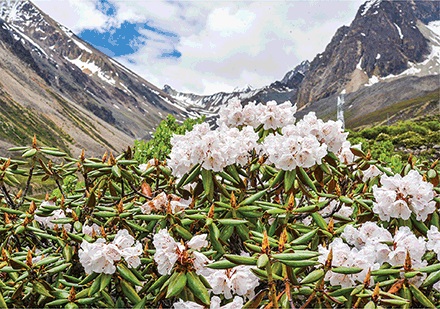
A showy Rhododendron is one of some 3000 alpine plant species found in the Hengduan Mountains.
The Hengduan Mountains adjoining Asia's massive Tibetan Plateau are a place of superlatives. Four major rivers, including the Mekong and the Yangtze, flow through deep valleys. In winter, snow blankets the peaks, and in summer fierce monsoon rains pelt them. And one of the world's richest alpine plant communities, boasting more than 3000 species, cloaks the slopes.
“It's a fascinating place, especially botanically,” says Richard Ree, an evolutionary biologist at the Field Museum. At first glance, he notes, the alpine meadows on the high slopes of the Hengduan peaks look like those found in other ranges, such as North America's Rocky Mountains. “But then you realize that there are 10 times more species.” The Rhododendrons, Primulas, and Gentians are particularly diverse.
The plant community is also much, much older, Ree and colleagues reveal on p. 578. It originated some 30 million years ago, tens of millions of years before those blanketing other mountains. That makes it the world's oldest continuous alpine ecosystem “by a long shot,” Ree says, which gave it far more time to diversify. Evolution also had a potent driver here, they conclude: intense monsoon rains, which provided essential moisture but also promoted erosion that carved up the landscape, dividing and isolating plant populations that ultimately diverged into new species.
The findings have implications both for understanding how geological and meteorological forces can mold plant communities and for predicting how they might cope with future climate and landscape changes, researchers say. “If we can understand how species and communities responded in the past,” says botanist Pam Soltis of the Florida Museum of Natural History at the University of Florida, “we might have a better handle on how fragile they may be over the next century.”
Geologists have long puzzled over the complex history of the Hengduan range, which runs north to south mostly through southwestern China. Not long ago, they believed the peaks, which rise to 4500 meters, formed about 5 million years ago. But more recent studies, including new radiometric dating, suggest they arose some 30 million years ago.
To find out whether the region's plant history also stretched back that far, Ree and Wen-Na Ding, a Ph.D. student at the Xishuangbanna Tropical Botanical Garden in China, used DNA sequences to create evolutionary trees for each of the 18 plant groups found on the Tibetan Plateau, Himalayas, and Hengduan Mountains. They also used plant fossils to calibrate a timeline of when new species appeared and link it to key events in the region's geological history. The findings allowed them to estimate speciation rates, and how fast new species spread from one region to others.
The data pointed to “a surprising result,” Ree says: Some of the plant groups in the plateau originated in the Hengduan Mountains about 30 million years ago, far earlier than is known for other alpine flora. More new species arose as major geological events, such as the uplift of mountain chains, isolated plant populations some 19 million to 17 million years ago. Plant speciation accelerated again about 15 million years ago, when geologic evidence indicates monsoons intensified, reshaping the landscape. “Definitely, the monsoon has an enormous role to play,” says Adrien Favre, an evolutionary biology at the Senckenberg Research Institute and Natural History Museum. But he notes that global cooling at the time also would have spurred the evolution of alpine plants.
Along with time, topography, and weather, the diversity of Hengduan's flora may reflect good fortune. The region avoided the intense glaciation that wiped out ancient plant communities in other mountains. The range's north-south orientation of the mountains also might have helped, by giving plants an escape route to warmer climes, with their seeds carried south by animals, wind, or water.
Now, the question is how the Hengduan's ancient flora will cope with human activities, including a new climate threat. If upheavals long ago, rather than today's conditions, account for the region's superlative diversity, traditional approaches to predicting how plants will react to warming might not work, says Carsten Rahbek, a macroecologist at the University of Copenhagen. “The foundation of how we do biodiversity forecasting of climate change, especially in mountains, is probably on very shaky ground,” he says.
There is also a more pressing threat: development, in the form of new roads, hydroelectric dams, and growing settlements and farms. On the bright side, the stunning wildflower displays that appear each summer on the slopes of the Hengduan Mountains have made the region a growing draw for ecotourism, and prompted China's government to protect parts of this ancient cradle of plant diversity.
https://science.sciencemag.org/content/369/6503/493

